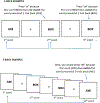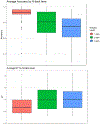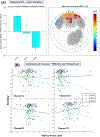Load-dependent relationships between frontal fNIRS activity and performance: A data-driven PLS approach
- PMID: 33503483
- PMCID: PMC8145788
- DOI: 10.1016/j.neuroimage.2021.117795
Load-dependent relationships between frontal fNIRS activity and performance: A data-driven PLS approach
Abstract
Neuroimaging research frequently demonstrates load-dependent activation in prefrontal and parietal cortex during working memory tasks such as the N-back. Most of this work has been conducted in fMRI, but functional near-infrared spectroscopy (fNIRS) is gaining traction as a less invasive and more flexible alternative to measuring cortical hemodynamics. Few fNIRS studies, however, have examined how working memory load-dependent changes in brain hemodynamics relate to performance. The current study employs a newly developed and robust statistical analysis of task-based fNIRS data in a large sample, and demonstrates the utility of data-driven, multivariate analyses to link brain activation and behavior in this modality. Seventy participants completed a standard N-back task with three N-back levels (N = 1, 2, 3) while fNIRS data were collected from frontal and parietal cortex. Overall, participants showed reliably greater fronto-parietal activation for the 2-back versus the 1-back task, suggesting fronto-parietal fNIRS measurements are sensitive to differences in cognitive load. The results for 3-back were much less consistent, potentially due to poor behavioral performance in the 3-back task. To address this, a multivariate analysis (behavioral partial least squares, PLS) was conducted to examine the interaction between fNIRS activation and performance at each N-back level. Results of the PLS analysis demonstrated differences in the relationship between accuracy and change in the deoxyhemoglobin fNIRS signal as a function of N-back level in eight mid-frontal channels. Specifically, greater reductions in deoxyhemoglobin (i.e., more activation) were positively related to performance on the 3-back task, unrelated to accuracy in the 2-back task, and negatively associated with accuracy in the 1-back task. This pattern of results suggests that the metabolic demands correlated with neural activity required for high levels of accuracy vary as a consequence of task difficulty/cognitive load, whereby more automaticity during the 1-back task (less mid-frontal activity) predicted superior performance on this relatively easy task, and successful engagement of this mid-frontal region was required for high accuracy on a more difficult and cognitively demanding 3-back task. In summary, we show that fNIRS activity can track working memory load and can uncover significant associations between brain activity and performance, thus opening the door for this modality to be used in more wide-spread applications.
Keywords: Cognitive load; N-back task; Neural efficiency; Partial least squares; Working memory; fNIRS.
Copyright © 2021. Published by Elsevier Inc.
Conflict of interest statement
Declaration of Competing Interest The authors declare no conflicts of interest.
Figures







Similar articles
-
Neuroimaging and cognition using functional near infrared spectroscopy (fNIRS) in multiple sclerosis.Brain Imaging Behav. 2015 Jun;9(2):302-11. doi: 10.1007/s11682-014-9307-y. Brain Imaging Behav. 2015. PMID: 24916919
-
Probing the early development of visual working memory capacity with functional near-infrared spectroscopy.Neuroimage. 2014 Jan 15;85 Pt 1(0 1):314-25. doi: 10.1016/j.neuroimage.2013.05.034. Epub 2013 May 23. Neuroimage. 2014. PMID: 23707803 Free PMC article.
-
Using multivariate partial least squares on fNIRS data to examine load-dependent brain-behaviour relationships in aging.PLoS One. 2024 Oct 14;19(10):e0312109. doi: 10.1371/journal.pone.0312109. eCollection 2024. PLoS One. 2024. PMID: 39401216 Free PMC article.
-
Applications of Functional Near-Infrared Spectroscopy (fNIRS) Neuroimaging in Exercise⁻Cognition Science: A Systematic, Methodology-Focused Review.J Clin Med. 2018 Nov 22;7(12):466. doi: 10.3390/jcm7120466. J Clin Med. 2018. PMID: 30469482 Free PMC article. Review.
-
Lights on music cognition: A systematic and critical review of fNIRS applications and future perspectives.Brain Cogn. 2024 Oct;180:106200. doi: 10.1016/j.bandc.2024.106200. Epub 2024 Jun 21. Brain Cogn. 2024. PMID: 38908228
Cited by
-
Brain activation during the N-back working memory task in individuals with spinal cord injury: a functional near-infrared spectroscopy study.bioRxiv [Preprint]. 2024 Feb 12:2024.02.09.579655. doi: 10.1101/2024.02.09.579655. bioRxiv. 2024. PMID: 38405769 Free PMC article. Preprint.
-
The Validation of a Portable Functional NIRS System for Assessing Mental Workload.Sensors (Basel). 2021 May 31;21(11):3810. doi: 10.3390/s21113810. Sensors (Basel). 2021. PMID: 34072895 Free PMC article.
-
A multimodal dataset for investigating working memory in presence of music: a pilot study.Front Neurosci. 2024 Jun 19;18:1406814. doi: 10.3389/fnins.2024.1406814. eCollection 2024. Front Neurosci. 2024. PMID: 38962177 Free PMC article.
-
Investigating mental workload-induced changes in cortical oxygenation and frontal theta activity during simulated flights.Sci Rep. 2022 Apr 19;12(1):6449. doi: 10.1038/s41598-022-10044-y. Sci Rep. 2022. PMID: 35440733 Free PMC article.
-
Differences in Performance of ASD and ADHD Subjects Facing Cognitive Loads in an Innovative Reasoning Experiment.Brain Sci. 2021 Nov 18;11(11):1531. doi: 10.3390/brainsci11111531. Brain Sci. 2021. PMID: 34827530 Free PMC article.
References
-
- Awh E, Jonides J, Smith EE, Schumacher EH, Koeppe RA, Katz S, 1996. Dissociation of storage and rehearsal in verbal working memory: evidence from positron emission tomography. Psychol. Sci 7 (1), 25–31.
-
- Ayaz H, Shewokis PA, Bunce S, Izzetoglu K, Willems B, Onaral B, 2012. Optical brain monitoring for operator training and mental workload assessment. Neuroimage 59 (1), 36–47. - PubMed
-
- Benjamini Y, Hochberg Y, 1995. Controlling the false discovery rate: a practical and powerful approach to multiple testing. J. R. Stat. Soc. Ser. B Stat. Methodol 57 (1), 289–300.
Publication types
MeSH terms
Grants and funding
LinkOut - more resources
Full Text Sources
Other Literature Sources

